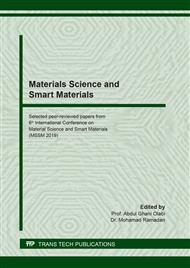p.49
p.55
p.61
p.67
p.73
p.79
p.85
p.91
p.97
Three-Disperse Magnetorheological Fluids Based on Ferrofluids Induced Modification of Sedimentation by Addition of Nanoparticles
Abstract:
The effect of mixing suspended nanoparticles into a bi-disperse magneto-rheological fluid on sedimentation phenomena is explored. A reference bi-disperse MRF has been modified using a ferrofluid containing magnetite nanoparticles of two shapes (spheres or hexagonal platelets) suspended in paraffin-oil as carrier fluid. The reference MRF was prepared with a mixture of two diameter sizes for the micrometric particles. The reference MRF was also prepared using two different grades of carbonyl-iron micrometric particles (herein these will be referred to as HARD and SOFT), which differ each other for their mechanical properties. The experiment monitored the evolution with time of the sediment-supernatant interface. This experiment showed that the presence of nanoparticles (particularly the spherical ones) slows down the sedimentation effects in terms of ratio and rate, independently of the other characteristics of the fluid. This study also showed that fluids based on SOFT carbonyl iron powders, in presence of nanospheres, are more stable than HARD carbonyl iron powder based fluids, since their sedimentation rate slows down in the long term. At the same time, HARD particle-based magnetorheological fluids show smaller sedimentation ratios than SOFT based fluids.
Info:
Periodical:
Pages:
73-78
Citation:
Online since:
September 2020
Price:
Сopyright:
© 2020 Trans Tech Publications Ltd. All Rights Reserved
Share:
Citation:


